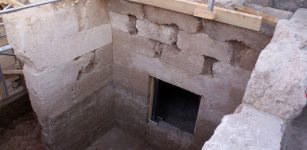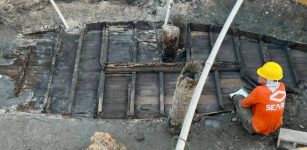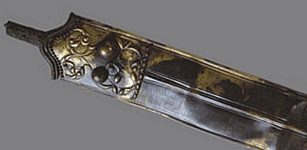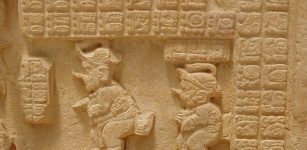Pandavleni Buddhist Caves: Sculptures, Inscriptions And Sophisticated Water Management System
A. Sutherland - AncientPages.com - Pandavleni (Pandav Leni) Caves were built from the 1st century BC to the 2nd century AD. They form a large complex of the 24 early Buddhist caves, of which some contain numerous chambers.
They are located approximately 8km south of the city of Nashik, in the western state of Maharastra, India. The history of Nashik dates back to prehistoric times and excavations carried out in the area confirmed that people lived om the banks of the river Godavarifrom the Chalcolithic age dating back to about 1,400 – 1,300 BC.
These rock-cut caves have beautiful pillared entrances; in total, caves contain 27 inscriptions in Brahmi script.
Pandavleni Caves are Hinayana Buddhist caves; there are many different schools and traditions of Buddhism, and these schools are often divided into the three Yanas (meaning 'Vehicles' or 'Paths'). These three are: the Hinayana, Mahayana and Tantrayana.
The caves served as monasteries (‘viharas’) for the disciples to meet, listen to sermons and meditate.
Some of Pandavleni caves are interconnected by stone cut ladders. There are also rock-cut water tanks once used by Buddhist monks. It is an ancient and very sophisticated water management system accompanied by several skillfully chiseled out of solid rock water tanks; these tanks are still functioning.
India's tradition of establishing water tanks is very old and represents a masterpiece of engineering.
In ancient times, the temple tank in India, always had water, even when all other sources had dried up.
See also:
Ajanta Caves: Incredible Accomplishment Of India’s Ancient Stonecutters
Gigantic Kailasa Temple Emerging From A Mountainside: Engineering Marvel Of India’s Master Builders
The main cave of the Pandavleni complex has a beautiful stupa (‘Chaitya’ or 'prayer hall') and almost all rock-cut chambers have their own unique carvings. There are large idols of Lord Buddha and icons of Bodhisattva (enlightened beings who have put off entering paradise in order to help others attain enlightenment.)
Two of all caves are particularly interesting; they have carvings, animal figures and dice boards once engraved into stone floors by monks who lived there. The inscriptions on the walls of the caves also describe local kings.
According to one of many ancient legends, Pandavas, the five sons of Pandu, a great warrior, described in a Hindu epic, Mahabharata, made these caves, while hiding away from their enemies.
However, historical facts and inscriptions found in the caves confirm that the city of Nashik, where the caves are located, in that period was ruled by 3 kings, who not only supported the building of the caves, but also local landlords and merchants, donated huge sums for their development.
The caves’ more ancient name is Trirashmi (“triple royal”) Caves.
Written by – A. Sutherland AncientPages.com Staff Writer
Copyright © AncientPages.com All rights reserved. This material may not be published, broadcast, rewritten or redistributed in whole or part without the express written permission of AncientPages.com
Expand for referencesMore From Ancient Pages
-
 New Macedonian-Era Tomb With Four Chambers Was Discovered In Pella
Archaeology | Dec 23, 2015
New Macedonian-Era Tomb With Four Chambers Was Discovered In Pella
Archaeology | Dec 23, 2015 -
 Humans’ Oldest Jawed Ancestor Is A 439-Million-Year-Old Spiky Shark – Surprising Discovery Shows
Archaeology | Sep 29, 2022
Humans’ Oldest Jawed Ancestor Is A 439-Million-Year-Old Spiky Shark – Surprising Discovery Shows
Archaeology | Sep 29, 2022 -
 Evidence Of Brain Surgery Performed 3,000 Years Ago Discovered In Tel Megiddo, Israel
Archaeology | Feb 23, 2023
Evidence Of Brain Surgery Performed 3,000 Years Ago Discovered In Tel Megiddo, Israel
Archaeology | Feb 23, 2023 -
 Extraordinary Gold Treasures Found In A Thracian Warrior’s Grave Near Topolovgrad, Bulgaria
Archaeology | Aug 26, 2024
Extraordinary Gold Treasures Found In A Thracian Warrior’s Grave Near Topolovgrad, Bulgaria
Archaeology | Aug 26, 2024 -
 Carved Symbols Related To The Galician Castro Culture Discovered At Castro de San Vicenzo, Orense, Spain
Archaeology | Oct 11, 2024
Carved Symbols Related To The Galician Castro Culture Discovered At Castro de San Vicenzo, Orense, Spain
Archaeology | Oct 11, 2024 -
 Remarkable Discovery Of A 19th-Century Boat Buried Under A Road In St. Augustine, Florida
Archaeology | Oct 16, 2023
Remarkable Discovery Of A 19th-Century Boat Buried Under A Road In St. Augustine, Florida
Archaeology | Oct 16, 2023 -
 On This Day In History: Aviator Amelia Earhart Was The First Woman To Cross The Atlantic By Air – On June 18, 1928
News | Jun 18, 2016
On This Day In History: Aviator Amelia Earhart Was The First Woman To Cross The Atlantic By Air – On June 18, 1928
News | Jun 18, 2016 -
 Does Celtic Art Have Links With Iron Age Art Of The Eurasian Steppes?
Archaeology | Oct 15, 2015
Does Celtic Art Have Links With Iron Age Art Of The Eurasian Steppes?
Archaeology | Oct 15, 2015 -
 In The Neanderthal Site Of Combe-Grenal, France: Hunting Strategies Were Unaffected By Changing Climate
Archaeology | Jan 19, 2023
In The Neanderthal Site Of Combe-Grenal, France: Hunting Strategies Were Unaffected By Changing Climate
Archaeology | Jan 19, 2023 -
 Cursed Dwarf Fafnir Turned Into A Fearsome Norse Dragon And Guarded The Stolen Magical Ring Andvaranaut
Featured Stories | Aug 16, 2017
Cursed Dwarf Fafnir Turned Into A Fearsome Norse Dragon And Guarded The Stolen Magical Ring Andvaranaut
Featured Stories | Aug 16, 2017 -
 Monumental Grave Of Ancient Greek Poet Aratus Located In Mersin- But It Cannot Be Opened
Archaeology | Jun 4, 2017
Monumental Grave Of Ancient Greek Poet Aratus Located In Mersin- But It Cannot Be Opened
Archaeology | Jun 4, 2017 -
 Alux: Little Mythical Troublemaker And Guardian Of Corn Fields In Mayan Folklore
Featured Stories | Jun 11, 2019
Alux: Little Mythical Troublemaker And Guardian Of Corn Fields In Mayan Folklore
Featured Stories | Jun 11, 2019 -
 Surprising Discovery Of Ancient Roman Salt Factory In England
Archaeology | Oct 8, 2020
Surprising Discovery Of Ancient Roman Salt Factory In England
Archaeology | Oct 8, 2020 -
 On This Day In History: Pakal Ascends The Throne Of Palenque At Age Of 12 – On July 29, 615
News | Jul 29, 2016
On This Day In History: Pakal Ascends The Throne Of Palenque At Age Of 12 – On July 29, 615
News | Jul 29, 2016 -
 Hundreds Of 19th-Century Skulls Collected In The Name Of Medical Science Tell A Story Of Who Mattered And Who Didn’t
Featured Stories | Nov 14, 2024
Hundreds Of 19th-Century Skulls Collected In The Name Of Medical Science Tell A Story Of Who Mattered And Who Didn’t
Featured Stories | Nov 14, 2024 -
 12 Masonic Symbols Explained
Ancient Symbols | Jul 2, 2018
12 Masonic Symbols Explained
Ancient Symbols | Jul 2, 2018 -
 Cerberus – Giant Multi-Headed Dog Guards The Underworld Of God Hades In Greek Mythology
Featured Stories | Jun 2, 2020
Cerberus – Giant Multi-Headed Dog Guards The Underworld Of God Hades In Greek Mythology
Featured Stories | Jun 2, 2020 -
 Mystery Of The Ancient Moonless Ones – Strange Tales Of Unusual Lost Civilizations
Ancient Mysteries | Jan 29, 2022
Mystery Of The Ancient Moonless Ones – Strange Tales Of Unusual Lost Civilizations
Ancient Mysteries | Jan 29, 2022 -
 Mawangdui Medical Manuscripts: Oldest Surviving Anatomical Atlas In The World
News | Sep 2, 2020
Mawangdui Medical Manuscripts: Oldest Surviving Anatomical Atlas In The World
News | Sep 2, 2020 -
 On This Day In History: He Wanted The Bible To Be Available To All – Burned At The Stake On Oct 6, 1536
News | Oct 6, 2016
On This Day In History: He Wanted The Bible To Be Available To All – Burned At The Stake On Oct 6, 1536
News | Oct 6, 2016


